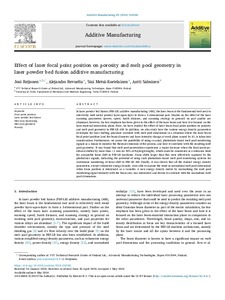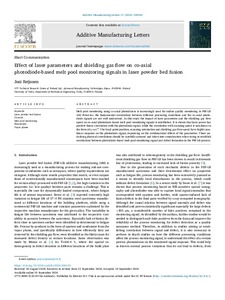Effect of laser beam angle of incidence on surface roughness and porosity of IN718 parts manufactured via laser powder bed fusion
Tolvanen, Einari (2024-10-31)
Effect of laser beam angle of incidence on surface roughness and porosity of IN718 parts manufactured via laser powder bed fusion
Tolvanen, Einari
(31.10.2024)
Julkaisu on tekijänoikeussäännösten alainen. Teosta voi lukea ja tulostaa henkilökohtaista käyttöä varten. Käyttö kaupallisiin tarkoituksiin on kielletty.
avoin
Julkaisun pysyvä osoite on:
https://urn.fi/URN:NBN:fi-fe2024111391319
https://urn.fi/URN:NBN:fi-fe2024111391319
Tiivistelmä
Laser powder bed fusion of metal (PBF-LB/M) is a rapidly evolving digital manufacturing technology
paving the way for a new industrial revolution. It has attracted attention in industry and academia
thanks to its ability to produce complex geometries, while maintaining cost-efficiency in low-volume
production. The utilization of laser beam in layer-by-layer fusion of metal powder induces certain
challenges related to the quality of the manufactured components. In recent years, researchers have
reported variations in defect formation depending on the location of the manufactured components on
the build platform. Several explanations have been provided for these variations, one of which is the
laser beam angle of incidence (LBAI), which varies across the build platform.
The aim of this thesis is to investigate the effect of LBAI on surface roughness and porosity of Inconel
718 (IN718) parts manufactured via PBF-LB/M. The proposed part characterization methodology can
be used as a benchmark in process development that aims to mitigate the formation of the studied
defects. Experiments were conducted by characterizing the laser beam and by fabricating different
geometries at different build platform locations. Surface roughness and porosity was analyzed from
the fabricated test parts.
Results in the current work indicate that the laser beam spot is prone to elongation when the LBAI is
increased, which can lead to loss of energy density at the spot periphery. Surface roughness
characterization demonstrated that the effect of LBAI depends on the surface orientation in relation to
the laser beam incidence. Based on the findings, it is anticipated that the laser beam that is aligned
parallel to the fabricated surface yields the most optimal surface roughness. Porosity characterization
showed that the effect of LBAI is negligible when using parameters that are optimized to yield fully
dense parts. On the contrary, parameters that yielded lack of fusion showed distinct increase in
porosity when LBAI was increased. Additionally, opportunities for future research were identified,
which includes the effect of laser beam scanning strategy and the effect of inert gas flow conditions
across the powder bed.
paving the way for a new industrial revolution. It has attracted attention in industry and academia
thanks to its ability to produce complex geometries, while maintaining cost-efficiency in low-volume
production. The utilization of laser beam in layer-by-layer fusion of metal powder induces certain
challenges related to the quality of the manufactured components. In recent years, researchers have
reported variations in defect formation depending on the location of the manufactured components on
the build platform. Several explanations have been provided for these variations, one of which is the
laser beam angle of incidence (LBAI), which varies across the build platform.
The aim of this thesis is to investigate the effect of LBAI on surface roughness and porosity of Inconel
718 (IN718) parts manufactured via PBF-LB/M. The proposed part characterization methodology can
be used as a benchmark in process development that aims to mitigate the formation of the studied
defects. Experiments were conducted by characterizing the laser beam and by fabricating different
geometries at different build platform locations. Surface roughness and porosity was analyzed from
the fabricated test parts.
Results in the current work indicate that the laser beam spot is prone to elongation when the LBAI is
increased, which can lead to loss of energy density at the spot periphery. Surface roughness
characterization demonstrated that the effect of LBAI depends on the surface orientation in relation to
the laser beam incidence. Based on the findings, it is anticipated that the laser beam that is aligned
parallel to the fabricated surface yields the most optimal surface roughness. Porosity characterization
showed that the effect of LBAI is negligible when using parameters that are optimized to yield fully
dense parts. On the contrary, parameters that yielded lack of fusion showed distinct increase in
porosity when LBAI was increased. Additionally, opportunities for future research were identified,
which includes the effect of laser beam scanning strategy and the effect of inert gas flow conditions
across the powder bed.
Samankaltainen aineisto
Näytetään aineisto, joilla on samankaltaisia nimekkeitä, tekijöitä tai asiasanoja.
-
Effect of laser focal point position on porosity and melt pool geometry in laser powder bed fusion additive manufacturing
Reijonen Joni; Revuelta Alejandro; Metsä-Kortelainen Sini; Salminen AnttiIn laser powder bed fusion (PBF-LB) additive manufacturing (AM), the laser beam is the fundamental tool used to selectively melt metal powder layer-upon-layer to form a 3-dimensional part. Studies on the effect of the laser ... -
Effect of laser parameters and shielding gas flow on co-axial photodiode-based melt pool monitoring signals in laser powder bed fusion
Reijonen, JoniMelt pool monitoring using co-axial photodiodes is increasingly used for online quality monitoring in PBF-LB AM. However, the fundamental correlations between different processing conditions and the co-axial photodiode ... -
Laser beam shaping effects to quality and productivity in Laser powder bed fusion technology
Lainio, Valtteri (29.05.2024)Laser powder bed fusion (BPF-LB/M) process has over 100 process parameters. In this literature review the effects of laser beam shaping to BPF-LB/M are studied beside of main parameters. Considered effects are quality ...avoin



